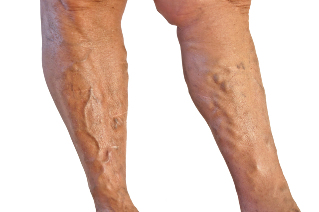Varicose veins (varicose veins) is a chronic disease, which is characterized by blocking of the veins to the violation of the blood flow and the stagnation in the venous system.
In a first time, varicose veins do not cause any discomfort and which is the cause of the cosmetic defects: the appearance of translucent through the skin and gnarled veins, blue-brown hue.

The symptoms of varicose veins
You must go to phlebologist, if you find at least one of the symptoms of varicose veins:
- translucent through the skin meanders of the veins of the legs;
- a feeling of heaviness in the legs, fatigue;
- patchy brownish pigmentation of the skin on the legs and ankles;
- periodic pain in the legs;
- swelling of the legs and the feet, which usually appear after a long standing or sitting with the feet;
- episodic cramps in the muscles of the lower limbs;
- in the last stages of the disease lesion of the defects on the skin of the feet or in the joints.
Noticing the first signs of vein disease, don't hesitate, contact immediately a phlebologist. The most recent diagnostic equipment to get rid of varicose veins, allows physicians to identify the disease at an early stage and prevent complications.
The main causes of the appearance of varicose veins
To varicose veins cite most often:
- congenital weakness of the venous wall, which predisposes to the development of varicose veins and is hereditary;
- gender – women suffer from varicose veins in the legs two times more often than men. According to one theory, this is due to the wearing of high heels;
- long stay on the feet. Often varicose veins suffer the people of the profession that are related to the work "on its feet": the vendors, the teachers, hairdressers, and others;
- the age of the varicose veins often develops after the age of 45;
- the lack of exercise, a job that requires a long stay standing or a sedentary lifestyle;
- needless to intense physical activity;
- obesity and overweight.
The phase of varicose veins
Phase 1 – phase payment. Descriptions of the manifestations of the venous insufficiency is not. Concerned about the discomfort and fatigue of the feet.
2 phase – phase subcompensation. Appear painful sensations, the veins start to be swollen under the skin in the form of nodes.
3 phase – the phase of decompensation. Characterized by pronounced violations of the blood flow of the lower limbs, develop trophic of the skin breakdown, risk for the development of long-term non-healing venous ulcers.
In a clinic for the treatment of varicose vein disease, you need to contact already when the symptoms appear, the first phase will be easier and faster to get rid of the disease, but also prevent complications.
Complications of varicose veins
Lipodermatosclerosis \ white atrophy of the skin
Lipodermatosclerosis is fibrous the rebirth of the skin and subcutaneous fat. The tissues lose their elasticity and mobility. The extreme form of lipodermatosclerosis white atrophy of the skin.
Food eczema \ dermatitis
Eczema occurs during the later stages of varicose veins and represents the inflammation and redness of the skin on the feet. During the progression of varicose veins deteriorates the nutrition of the skin, which later leads to the appearance of venous ulcers.

Thrombosis of the veins
At the base of this complication of the varicose disease – the formation of blood clots (thrombi) in the deep veins of the legs, which with a current of blood can enter the heart or lungs. The state requires a medical assistance!
Thrombophlebitis
Thrombophlebitis – inflammation of the vein wall with the formation of a blood clot, a unit of measure of the lumen of the vessel. In most cases, thrombophlebitis is the result of "execution" of the form of varicose veins.
Ulcer trophic
This long-term healing of a defect of the skin that develops on the background of venous stasis, requires a complex treatment.
The bleeding varices
The bleeding occurs most often of trophic venous ulcers, but can be and varicose veins. First aid in case of bleeding from varices: you must apply a pressure bandage with directly on the site of the bleeding, the leg of the lift to the top of the vial, following hospitalization.
Prevention of varicose veins
Order of never having varicose veins, it is necessary:
- on the possibility to avoid long periods of standing or sitting, to abandon the habit of staying long in the position of the leg on the leg;
- not to admit of the extra pounds;
- engaging in regular physical activity (fitness, swimming etc);
- choose comfortable shoes, try not to wear high-heeled shoes every day.
The treatment of varicose veins
Today, the removal of varicose veins on the legs, usually without traumatic interventions, as even 10-15 years ago. The recovery after the treatment takes a minimum of time!




































